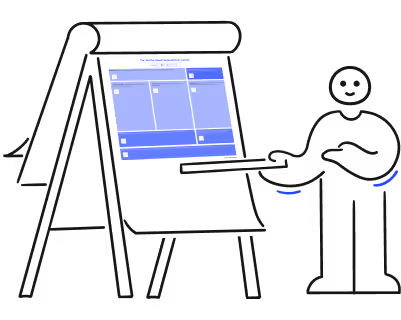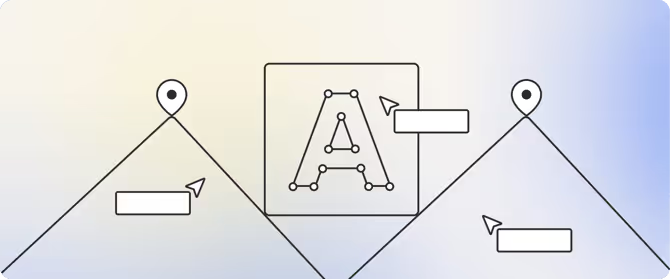How managers can use AI to accelerate their employees' growth

Empower your organization with the skills-based canvas.

The rise of Artificial Intelligence (AI) in the world is nothing short of revolutionary. According to Gartner, 81% of HR professionals have already explored or implemented this technology to improve process efficiency and decision-making.
That said, AI is still a relatively new tool. As keen as HR managers are to jump on the bandwagon — some questions need answers. Can AI truly transform existing HR management practices? How can it be integrated into employee development? Is AI a realistic solution for people management, or is it simply too good to be true?
Unlocking employee potential: How AI can support skills development and career progression
How does AI apply to HR management, exactly? Depending on the software, today’s AI tools offer many possible applications for familiar processes — from talent recruitment to performance management to workforce planning.
For instance, AI-powered algorithms can analyze resumes, assess skills, and identify top candidates to support screening and hiring efforts. Virtual assistants or chatbots can elevate training and onboarding, guiding new hires and employees through a more personalized and engaging experience. AI tools can also collect and analyze performance data to pinpoint skills gaps, tailor career progression paths with more precision, and provide real-time feedback to employees and managers. And the list goes on.
Through its machine learning and automation capabilities, AI has can transform traditional HR processes to be more data-driven, personalized, and efficient than ever. A study by Deloitte highlights how AI-driven tools have liberated HR professionals from mundane administrative tasks, allowing them to focus on more strategic initiatives like talent development and employee engagement.
The impact of AI on customized learning
Personalized career development and support are imperative to today's workforce. Compared to previous generations, millennials and Gen Z workers prioritize learning and development opportunities within their current jobs.
AI-powered software can play a big role in shaping customized growth paths for employees. Once a daunting task of collecting skills assessments and spreadsheets, multiplied by however many employees — by the time a team's skills are mapped out, you're probably halfway through the year and still need to begin to search for appropriate training.
Sound familiar?
Enter an AI-powered solution that can:
- identify an employee's skill gaps and learning preferences
- source and suggest appropriate training, and, ultimately,
- help managers craft more effective, personalized career progression plans at scale.
Let's look at Workleap Skills, for example. The solution leverages AI to recommend the best way to fill the skills gaps in a role and help employees accelerate their growth with an intentional, tangible, and actionable progression plan. The personalized progression plans are generated in a few clicks, mapping a clear path forward, whether that's a project milestone, promotion, or lateral move. Once skills (and gaps) are mapped, it makes it way easier to create structured and personalized training – quick! Double down on development by pairing with a learning management system to guide and monitor the training, and BOOM, you'll unlock new levels of internal talent.
Tips to integrate AI into your employee development processes
The world of people management is quickly recognizing the value AI offers to support employee development. Like any new tool adoption, seamless integration is key. Here’s how you can smoothly bring AI into the picture:
- Have a good understanding of current needs: Begin by conducting an assessment of your team’s existing skill sets. Using AI tools like Workleap Skills can streamline this process by automatically mapping out skills, strengths, and areas for improvement. Or, there’s the traditional “pen and paper” approach of collecting self assessments into spreadsheets. This initial step helps you pinpoint exactly where AI can have the most immediate and impactful application in addressing skills gaps.
- Make sure your objectives for AI are clear: Clarify your goals for adopting AI within the framework of employee development. For instance, if your objective is to enhance personalized learning, consider AI platforms that offer adaptive learning paths tailored to each employee’s unique skill set and career aspirations. This ensures your AI initiatives are directly tied to elevating the employee experience and meeting business targets.
- Pick the right tools for your team: Choose AI tools that align with your specific needs, such as an AI-driven learning management system (LMS) that offers customizable course creation and skills tracking. For personalization and autonomy, platforms that provide employees with self-directed learning opportunities and real-time progress tracking are invaluable. An example is an AI tool that suggests relevant courses based on an individual’s career trajectory and learning pace.
- Loop in your employees: Foster a culture of open feedback by involving employees in the selection and implementation phases of AI tools. This can be achieved through pilot programs or focus groups where employees test AI functionalities and provide feedback on their user experience, addressing any concerns and identifying the most beneficial features.
- Blend AI with human insights: Use AI to complement and enhance human interactions rather than replace them. Implement AI-driven analytics platforms that provide managers with detailed insights into team dynamics, individual performance, and development needs. This data can inform one-on-one development discussions, making them more targeted and meaningful.
- Monitor, listen, and stay flexible: Keep a pulse on the effectiveness of AI tools through regular performance reviews and collecting feedback from users. If an AI solution is not meeting the anticipated development goals, be prepared to pivot and explore alternative solutions. Success metrics might include improved employee engagement scores, faster skill acquisition rates, or increased internal mobility.
AI-powered tools can be a game-changer for teams if used correctly. It's not just about adopting new technology; it's about leveraging AI to build a more skilled, engaged, and adaptable workforce.
AI: Enhancing collaboration and mentorship behind-the-scenes
AI solutions exist to enrich team dynamics, not replace them. They have the potential to boost collaboration and enhance mentorship activities, both essential aspects of employee development — but how?
AI-powered talent management platforms leverage capabilities like skill mapping and succession planning not just to pinpoint skills and gaps within teams. They can intelligently match mentors and mentees. By analyzing data on skills, interests, and career aspirations, these tools can facilitate the most synergistic mentorship pairings, fostering professional growth and knowledge sharing.
AI’s predictive insights can also identify internal opportunities to help employees take their careers to the next level — assisting HR in internal mobility planning. This targeted approach makes sure that talent development aligns with organizational needs and employee aspirations. The result? A dynamic environment where everyone is primed for success.

Forecasting future skill needs: The predictive powers of AI
A team’s future success shouldn’t be left up to chance. That’s why predicting skill needs has become such an art. The role of talent development is to understand the skills at hand, see the potential in employees, and anticipate upcoming workforce gaps.
When used judiciously, AI’s predictive analytics takes the guesswork out of forecasting industry trends. Like Workleap Skills: It taps into 75 million data points from job markets and job postings to keep internal skills relevant and at the forefront of market demands. It takes calculated anticipation to a whole new level.
AI can also neutralize inherent biases that influence a manager's decision-making, particularly in recognizing and nurturing talent. AI democratizes career growth opportunities by providing an unbiased, data-driven view of each employee's skills and potential, ensuring every team member has the chance to advance and excel.
The precision of AI in skill mapping and employee profiling can transform succession planning from an intuitive (and perhaps stressful) process into a strategic one. Tools that generate AI-driven progression plans not only streamline talent development but ensure it is aligned with individual aspirations and organizational goals.
Using AI for workforce forecasting doesn’t exactly predict the future. Still, it can actively shape it by enabling businesses to build a resilient and agile workforce ready to tackle tomorrow’s challenges.
Ethical considerations around implementing AI
As we delve deeper into navigating the world of AI and how it can accelerate career growth, there are undoubtedly some doubts. Critics often raise real concerns about data privacy and AI taking people's jobs. However, with careful consideration and safeguards in place, you can steer AI to become an enabler of human potential and organizational growth instead of a disrupter.
Data privacy: A concern turned advantage
Data privacy concerns take center stage as AI becomes more ingrained in HR processes. As of last year, 65% of employees are concerned about their data privacy when it comes to AI. Worries revolve around data breaches, third-party sharing, and employee surveillance.
Privacy concerns are valid in any technology adoption scenario, especially when it involves sensitive employee data. However, advanced AI solutions have robust data protection measures to safeguard personal information. Workleap Skills, for example, integrates end-to-end encryption and adheres to strict data privacy regulations, ensuring that employee information remains secure and confidential.
AI can also enhance data security through sophisticated algorithms that detect and prevent unauthorized access, turning a potential drawback into a compelling advantage for adopting AI in HR practices.
Job displacement vs. job enhancement
What's more, the rise of AI has invited conversations around honorable usage — including the ethical considerations around the impact of AI on job security and displacement, or even algorithm bias.
Traditional HR roles will not be replaced by AI, but they do need to seize the opportunity to be enhanced by it. Referencing the same Deloitte study as earlier, AI-driven tools have the power to free up HR professionals and managers from repetitive, time-consuming tasks. By automating mundane tasks, AI empowers HR professionals to devote more time to fostering human connections and strategizing for growth.
It is important to navigate these concerns delicately to not deny AI's value for businesses but also to make sure sensitive information is protected and ethics are consistently practiced.
Measuring impact: Metrics for AI-driven employee growth
To gauge the real difference AI makes in employee growth, the right metrics and key performance indicators (KPIs) matter. Some key ones include:
- Skills acquisition rate: This one will show managers how quickly employees are picking up new skills. Are AI-assisted learning tools helping accelerate skill acquisition? For the investment to be worthwhile, the answer should be yes.
- Employee engagement scores: How invested and satisfied are your team members? AI-powered personalization and chatbots should make the employee experience more tailored, engaging, and interactive.
- Time-to-promotion: This career progression metric can be linked to AI’s effectiveness in supporting employee development. Look at how long it takes deserving employees to move up the ladder compared to before the new tools.
By keeping tabs on these metrics, you get a clear picture of how AI impacts skills development, career progression, and the overall happiness of your team. Ongoing monitoring keeps you agile to ensure your AI-driven strategies are always in sync with your company's evolution.
Workleap Skills: The AI-powered growth solution in action
As organizations worldwide strive for optimal growth, integrating new AI applications within HR management is fast becoming the winning bet. And the key to achieving real, tangible impact is its seamless integration into existing processes.
Monitor, support, and optimize your team's professional development.


%20(1).avif)


.avif)
.avif)







